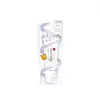What's inside
What's inside
 Key Ingredients
Key Ingredients

 Benefits
Benefits

 Concerns
Concerns

 Ingredients Side-by-side
Ingredients Side-by-side

Centella Asiatica Extract 41%
CleansingWater
Skin ConditioningLauryl Hydroxysultaine
CleansingGlycerin
HumectantDisodium Cocoamphodiacetate
CleansingPotassium Cocoyl Glycinate
Sodium Chloride
MaskingPotassium Cocoate
EmulsifyingSodium Lauroyl Glutamate
Vitis Vinifera Fruit Extract
Skin ConditioningPyrus Malus Fruit Extract
Skin ConditioningCarica Papaya Fruit Extract
Skin ConditioningPrunus Mume Fruit Extract
HumectantMadecassoside
Antioxidant1,2-Hexanediol
Skin ConditioningXylitylglucoside
HumectantAnhydroxylitol
HumectantXylitol
HumectantNiacinamide
SmoothingAcrylates/C10-30 Alkyl Acrylate Crosspolymer
Emulsion Stabilising3-O-Ethyl Ascorbic Acid
Skin ConditioningTrehalose
HumectantButylene Glycol
HumectantPanthenol
Skin ConditioningAgave Tequilana Leaf Extract
AstringentGlucose
HumectantCaprylic/Capric Triglyceride
MaskingHexylene Glycol
EmulsifyingPentylene Glycol
Skin ConditioningCitric Acid
BufferingPotassium Benzoate
PreservativeEthylhexylglycerin
Skin ConditioningDisodium EDTA
Centella Asiatica Extract 41%, Water, Lauryl Hydroxysultaine, Glycerin, Disodium Cocoamphodiacetate, Potassium Cocoyl Glycinate, Sodium Chloride, Potassium Cocoate, Sodium Lauroyl Glutamate, Vitis Vinifera Fruit Extract, Pyrus Malus Fruit Extract, Carica Papaya Fruit Extract, Prunus Mume Fruit Extract, Madecassoside, 1,2-Hexanediol, Xylitylglucoside, Anhydroxylitol, Xylitol, Niacinamide, Acrylates/C10-30 Alkyl Acrylate Crosspolymer, 3-O-Ethyl Ascorbic Acid, Trehalose, Butylene Glycol, Panthenol, Agave Tequilana Leaf Extract, Glucose, Caprylic/Capric Triglyceride, Hexylene Glycol, Pentylene Glycol, Citric Acid, Potassium Benzoate, Ethylhexylglycerin, Disodium EDTA
Arbutin
AntioxidantStearyl Glycyrrhetinate
Skin ConditioningWater
Skin ConditioningCyclopentasiloxane
EmollientButylene Glycol
HumectantZinc Oxide
Cosmetic ColorantEthyl Polysilicate
Glycerin
HumectantNeopentyl Glycol Dicaprate
EmollientPEG-8 Dimethicone
EmulsifyingMilk Ferment
Skin ConditioningGlycine Soja Extract
Skin ConditioningTitanium Dioxide
Cosmetic ColorantPhthalic Anhydride
Dipentaerythrityl Hexa C5-9 Acid Esters
Skin ConditioningSorbitan Fatty Acid Ester
EmulsifyingAlcohol Denat.
AntimicrobialXanthan Gum
EmulsifyingCitric Acid
BufferingGlycerin Methyl Ether
Gellan Gum
Tocopherol
AntioxidantPolyacrylic Acid
Emulsion StabilisingDecyltetradeceth-20
EmulsifyingMethyl Hexyl Ether
PerfumingMethyl/Phenyl Polysilsesquioxane
Aluminum Hydroxide
EmollientDimethylhydrogensiloxy Phenyl Polysilsesquioxane
Phenoxyethanol
PreservativeArbutin, Stearyl Glycyrrhetinate, Water, Cyclopentasiloxane, Butylene Glycol, Zinc Oxide, Ethyl Polysilicate, Glycerin, Neopentyl Glycol Dicaprate, PEG-8 Dimethicone, Milk Ferment, Glycine Soja Extract, Titanium Dioxide, Phthalic Anhydride, Dipentaerythrityl Hexa C5-9 Acid Esters, Sorbitan Fatty Acid Ester, Alcohol Denat., Xanthan Gum, Citric Acid, Glycerin Methyl Ether, Gellan Gum, Tocopherol, Polyacrylic Acid, Decyltetradeceth-20, Methyl Hexyl Ether, Methyl/Phenyl Polysilsesquioxane, Aluminum Hydroxide, Dimethylhydrogensiloxy Phenyl Polysilsesquioxane, Phenoxyethanol
 Reviews
Reviews

Ingredients Explained
These ingredients are found in both products.
Ingredients higher up in an ingredient list are typically present in a larger amount.
Butylene Glycol (or BG) is used within cosmetic products for a few different reasons:
Overall, Butylene Glycol is a safe and well-rounded ingredient that works well with other ingredients.
Though this ingredient works well with most skin types, some people with sensitive skin may experience a reaction such as allergic rashes, closed comedones, or itchiness.
Learn more about Butylene GlycolCitric Acid is an alpha hydroxy acid (AHA) naturally found in citrus fruits like oranges, lemons, and limes.
Like other AHAs, citric acid can exfoliate skin by breaking down the bonds that hold dead skin cells together. This helps reveal smoother and brighter skin underneath.
However, this exfoliating effect only happens at high concentrations (20%) which can be hard to find in cosmetic products.
Due to this, citric acid is usually included in small amounts as a pH adjuster. This helps keep products slightly more acidic and compatible with skin's natural pH.
In skincare formulas, citric acid can:
While it can provide some skin benefits, research shows lactic acid and glycolic acid are generally more effective and less irritating exfoliants.
Most citric acid used in skincare today is made by fermenting sugars (usually from molasses). This synthetic version is identical to the natural citrus form but easier to stabilize and use in formulations.
Read more about some other popular AHA's here:
Learn more about Citric AcidGlycerin is already naturally found in your skin. It helps moisturize and protect your skin.
A study from 2016 found glycerin to be more effective as a humectant than AHAs and hyaluronic acid.
As a humectant, it helps the skin stay hydrated by pulling moisture to your skin. The low molecular weight of glycerin allows it to pull moisture into the deeper layers of your skin.
Hydrated skin improves your skin barrier; Your skin barrier helps protect against irritants and bacteria.
Glycerin has also been found to have antimicrobial and antiviral properties. Due to these properties, glycerin is often used in wound and burn treatments.
In cosmetics, glycerin is usually derived from plants such as soybean or palm. However, it can also be sourced from animals, such as tallow or animal fat.
This ingredient is organic, colorless, odorless, and non-toxic.
Glycerin is the name for this ingredient in American English. British English uses Glycerol/Glycerine.
Learn more about GlycerinWater. It's the most common cosmetic ingredient of all. You'll usually see it at the top of ingredient lists, meaning that it makes up the largest part of the product.
So why is it so popular? Water most often acts as a solvent - this means that it helps dissolve other ingredients into the formulation.
You'll also recognize water as that liquid we all need to stay alive. If you see this, drink a glass of water. Stay hydrated!
Learn more about Water